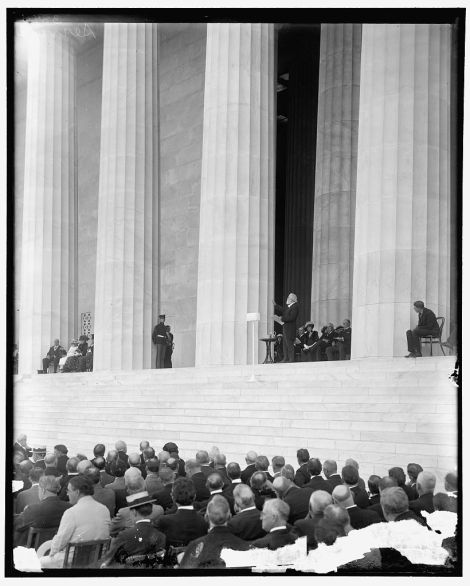
The Lincoln Memorial built between 1914 and 1922.
Washington DC hosts many monuments built in tribute to some of the country’s greatest leaders. The Lincoln Memorial is one such structure. The National Park Service administers the memorial and I have reprinted the brief history they post on their website at http://www.nps.gov/history/Nr/travel/wash/dc71.htm.
Once you have read this, scroll down to see some images of approved conceptual drawings, photographs of the memorial and surrounding grounds under construction and the May 30, 1922 Dedication Ceremonies. Enjoy.
LINCOLN MEMORIAL (reprinted from the National Park Service website)
The Lincoln Memorial stands at the west end of the National Mall as a neoclassical monument to the 16th President. The memorial, designed by Henry Bacon, after ancient Greek temples, stands 190 feet long, 119 feet wide, and almost 100 feet high. It is surrounded by a peristyle of 38 fluted Doric columns, one for each of the thirty six states in the Union at the time of Lincoln’s death, and two columns in-antis at the entrance behind the colonnade. The north and south side chambers contain carved inscriptions of Lincoln’s Second Inaugural Address and his Gettysburg Address. Lying between the north and south chambers is the central hall containing the solitary figure of Lincoln sitting in contemplation. The statue was carved in four years by the Piccirilli brothers under the supervision of the sculptor, Daniel Chester French. The statue of Lincoln is 19 feet high and weighs 175 tons. The original plan was for the statue to be only ten feet high, but this was changed so that the figure of Lincoln would not be dwarfed by the size of the chamber. A commission to plan a monument was first proposed in 1867, shortly after Lincoln’s death. The design for that plan called for six equestrian and 31 pedestrian statues of colossal size, with a 12-foot statue of Lincoln in the center. That project was never started for lack of funds. Congress approved the bill to construct this memorial in 1910. Construction began in 1914, and the memorial was opened to the public in 1922. The Memorial is visited by millions of visitors each year and is the site of many large public gatherings and protests. Martin Luther King, Jr. delivered his famous “I Have a Dream” speech to a crowd by the Lincoln Memorial in 1963 . Damaged over the years by heavy visitation and environmental factors, the Lincoln Memorial is currently undergoing a major restoration.
CONCEPTUAL DRAWINGS

A conceptual drawing from architect Henry Bacon's approved proposal for the Lincoln Memorial

Statue sculptor Daniel Chester French's approved 1/8" scale drawing of the 19'-0" high statue of Lincoln from late November, 1917

The foundation construction moving along in January, 1915.

Another view of the foundation construction from January 1915.
One year after the Ground Breaking ceremonies, the foundation was ready to receive the first cornerstone of the memorial. It was laid in place on Lincoln’s birthday February 12, 1915.

Laying the cornerstone for the Lincoln Memorial on Lincoln's birthday, February 12, 1915.

The colonnade and roof structure being constructed (c1916-17). The Washington Monument can be seen at lower left.

The foundation of the Lincoln Memorial carries an estimated weight of about 38,000 tons of granite and marble. The colonnade and frieze are being worked on in this photo.

The large cranes have now been removed as the roof is now completed. Work on the outer structure still continues.

The carvings on the exterior of the Lincoln Memorial were done by Washington D.C. sculptor, Ernest C. Bairstow. These carvings included eagles, festoons, wreathes and the states.

A close up of a carving on the frieze by architectural sculptor Ernest C. Bairstow.
Where Henry Bacon was the architect who designed the Lincoln Memorial, several sculptors and artists were responsible for the statues and carvings found throughout the building. Ernest C. Bairstow was a Washington D.C. architectural sculptor who was brought on to do the exterior carvings which included eagles, states, festoons and wreathes. He also did the carved letters on the interior.

The Piccirilli family and Daniel Chester French work on the assembly of the Lincoln statue.

The completed statue of Lincoln (c1943) with Mr. Royal Cotissoz's inscription above. The inscription was carved by Ernest C. Bairstow.

Construction on the marshlands dedicated for the Lincoln Memorial slowly take shape. The Reflecting Pool doesn't exist at this point and the area is used to hold materials and construction sheds.

Work well underway on the steps and surrounding exterior elements on the site. The steps lead down to the Reflecting Pool which currently hasn't been built yet.

The Reflecting Pool
————————————————————————————————–

The crowd gathered for the Lincoln Memorial Dedication Ceremonies on May 30, 1922.

Special guest Robert Lincoln (Abraham Lincoln's eldest son) arrives at the Dedication Ceremonies. The crowd gave him a loud ovation.

Chief Justice (and former President) William H. Taft, President Warren Harding and Robert Todd Lincoln.

Robert Lincoln took an active interest in the Lincoln Memorial while under construction. He often had his driver pass by to view it. On at least one occasion he obtained permission to enter the building during construction.

A view of the proceedings from the side of the Reflecting Pool.

Chief Justice Taft officially turns over the Lincoln Memorial to President Warren Harding who receives it on behalf of the people of the United States. Robert Lincoln looks on (seated lower left).

President Harding overlooks the crowd surrounding the Reflecting Pool.

The presenters are dwarfed by the Lincoln Memorial's massive marble columns.

Poet Edwin Markham reads a verse from his revised poem "Lincoln the Man of the People" to conclude the Dedication Ceremonies. Behind him sits Vice President Calvin Coolidge, President Warren Harding and Chief Justice William Howard Taft.

Alice Roosevelt Longworth (daughter of Teddy Roosevelt)(right) departs at the conclusion of the ceremonies.
Best




